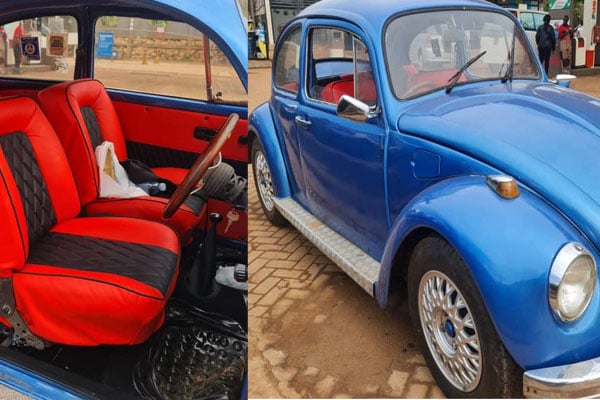Renault R4: Vintage with friendly fuel consumption

Before and after restoration. Like many other vintage cars, Renault R4’s spare parts are hard to get. Photo/Roland D. Nasasira
What you need to know:
Nakitende’s Renault R4 runs on a 900cc petrol engine. Although its fuel consumption cannot be compared to other cars with the same engine size due to old technology, it is still affordable.
Aidah Nakitende Ssemwanga is one of the few people in Kampala that drive a vintage car. Hers is the Renault R4, a 1973 model that was common on the streets of Kampala in the 1970s.
Then, it was commonly owned and driven by the Catholic Reverand Fathers and missionaries because not many people drove French brands. There are different other models of the Renault including the Renault GTL and Renault R4LT, among others.
Nakitende got her car after the owner, Father John Scabrian died. The caretakers at Emmaus Foundation in Luzira sold some of the properties Scabrian left behind, including the 49-year old car that had been turned into a makeshift store. At the time, it had been parked from 2013 to 2019 until Nakitende bought it.
It was in a poor mechanical condition and the steering rack was broken. Getting the steering rack took some time while other parts such as the suspension system and repainting of the car were done gradually at a cost of about Shs6m.
Specifications
Running on what is arguably the smallest engine with a 900cc petrol engine, the Renault R4 had the smallest engine size compared to cars such as the Peugeot 205, the Citroen and some Mercedes Benz models. Its fuel consumption was quite friendly.
“Now, its consumption cannot be compared to today’s 900cc engine sizes such as those of the Toyota Passo, Nissan March or even some Toyota Vitz models since the Renault R4’s technology is much older. While a Toyota Passo can take you for approximately 18kms per litre of fuel, the Renault 4 covers between 10 to 12 kilometres per litre,” Nakitende explains.
Maintenance
Like many other vintage cars, Renault R4’s spare parts are hard to get. However, it shares some parts such as the tyrod ends with the Peugeot 205 because they are both French brands and because there are garages that still deal in old French technology cars, Nakitende can easily get some spare parts.
Like many other cars, this car is serviced according to the mileage covered. It uses lubricants on the local market that give you 5,000kms.
“I only use it for special functions such as weddings which means I take long to cover 5,000kms,” Nakitende says.
Since she went through the restoration process, Nakitende does not go to the garage quite often because most of the parts she needed during restoration are still in good mechanical condition, except the air cleaner that needed changing a week ago.

“When you use the right parts, you will reduce the number of times you go to the garage. The challenge with sourcing for spares is that some of them are not locally available. Sometimes, you will have to order a part on ebay and it will take not less than two weeks to arrive in Uganda. Restoration is expensive and requires one to have a lot of patience and passion,” says John Burrows Lumu, a vintage car mechanic in Wandegeya.
Features
The Renault R4’s dashboard is basic and unique because of the gear shift.
The vehicle was locally known as sokola, a nickname that was derived from the way the gears are shifted. It involves pulling, pushing and turning. The gearshift is in the middle of the car but on the dashboard.
Whereas other dashboards have provisions for a radio, the one for the Renault R4 does not. Entertainment calls for improvising through using your phone to connect to a Bluetooth speaker.
It is a manual left hand driven car with four front gears and one reverse. It has a sitting capacity of four, while, according to its logbook, it weighs 980 kilogrammes, 20 shy of one ton. Its engine carries three litres of oil, while the fuel tank carries 31 litres of fuel at full tank capacity.
If you drive an average of 12kms per litre, it can go up to Mbarara District in western Uganda without refuelling. It has a maximum speed of 160km/hr but you cannot even risk driving at 100km/hr because it is a light car.
Performance
Running on hydraulic shock absorbers, the Renault R4 is comfortable for on and off-road drives. It is a car with the capability of being driven uphill because it generates its power from the front wheels.
It is also more spacious compared to the Toyota Passo, IST and a Vitz in terms of legroom.
It is smaller from the outside but big on the inside. Its boot can accommodate two metallic box suit cases of school going children.
Success
Thanks to such a versatile character, the R4 was hugely popular. In its super-long lifespan of 33 years, some 8.1 million units were sold, placing it just behind Volkswagen Beetle (21.5 million units), Ford Model T (15 million units) and Fiat Uno (8.8 million units) in all-time sales chart. Moreover, it promoted Renault to be a global car maker. It was marketed in 100 countries worldwide and assembled in 28 countries, including Morocco and Slovenia where its production ended in 1994.




